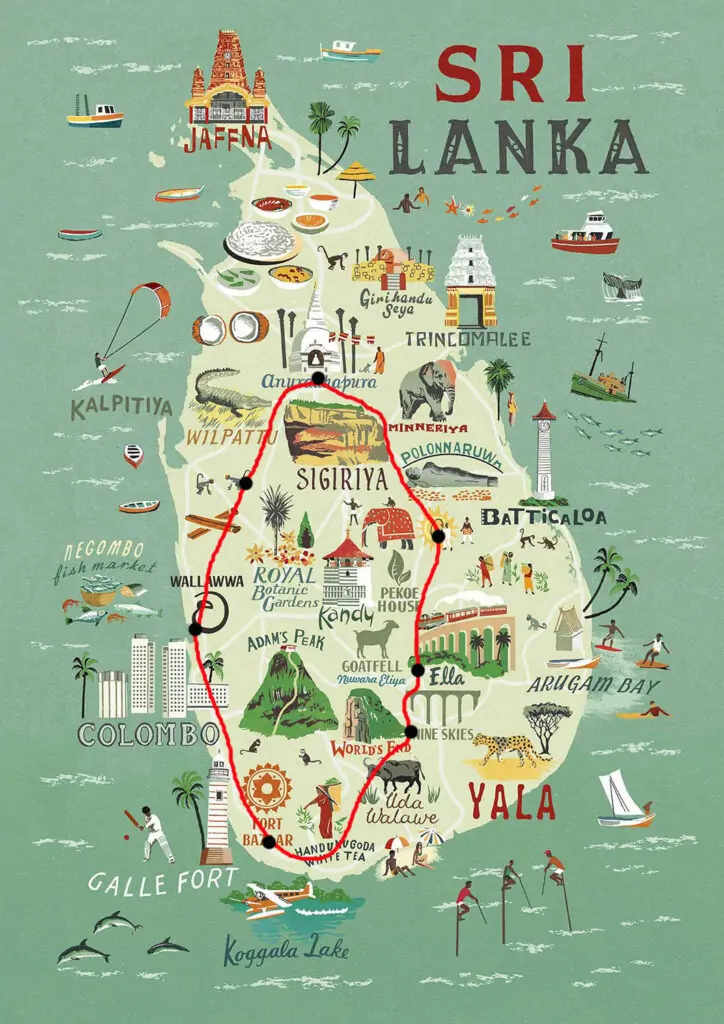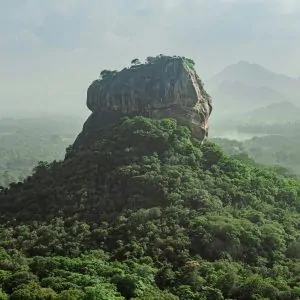Menu
Airport to Dambulla – Sigiriya Rock Fortress , Village Tour.
Dambulla to Anuradhapura – Aukana Statue , Explore anuradhapura
Anuradhaoura to Hasalaka -Rathna ella , Visit Vedda’s Village.
Hasalaka to Ella – Ella Rock , Ravana Falls , Explore Ella.
Ella to Haputale -Lipton’s Seat , Adisham Bungalow.
Haputale to Galle – Diyaluma Falls , Dutch Fortress Galle.
Departure – Mask Museum , Turtle Hatchery , Colombo City Tour.


On Sri Lanka’s west coast lies the seaside city of Negambo.It is well-known as a fishing center.Thus, Negambo is home to a large number of traditional fishermen. It is a destination for tourists. The variety of eateries, stores, bars, and lodging options in the city demonstrate how vibrant it is. The stunning city of Negambo, which was established by the Dutch, is encircled by tens of churches that make it seem like a miniature Vatican. The best spot to hang out is on the beach road.
Drive along the Negombo-Marawila beach road for a unique glimpse into the daily lives of fisherfolk. At every turn, local fishermen offer their fresh catches for sale, from tiny shrimp to enormous sharks. This route passes through traditional fishing villages in the west coast’s Catholic Belt, evident in the numerous churches and statues of saints dotting the landscape, reflecting the region’s distinctive demographics.
Sri Lanka boasts Arrack, a unique liquor made from Toddy, the sap of coconut flowers. Witness remarkable daredevils traversing tall coconut trees on slender ropes hundreds of meters above the ground. The coconut grove resembles a hanging grid of ropes. For an authentic experience, savor a delightful cup of freshly tapped Toddy when you arrive early in the morning.

The Pinnawala Elephant Orphanage offers a volunteer program that allows you to get up close and personal with these gentle giants. The program is a great way to learn about elephants, their care, and the challenges they face in the wild. Volunteers also play an important role in supporting the orphanage’s mission to provide a safe haven for rescued elephants.
You will assist the mahouts (elephant handlers) with a variety of tasks, such as cleaning enclosures, preparing food, bottle-feeding baby elephants, and bathing the elephants in the river. Volunteers working are four to six hours per day. You will have free time in the afternoons and evenings to explore the surrounding area.
It is important to choose a program that is committed to the welfare of elephants. Avoid programs that offer riding or other activities that could be harmful to the animals.

Arankele stands as a prominent Buddhist monastery and hermitage, offering walking paths, meditation centers, saunas, and care facilities for ailing Bikkhus. A visit transports you to another era and realm. Arriving early, you can assist meditating monks with their breakfast – a traditional Buddhist ceremony rich in rituals. This unique, holistic experience culminates with a serene meditation session amidst the mystic forest hermitage, creating a truly unforgettable lifetime memory.
One of the first and most thriving industries in ancient Sri Lanka was pottery. There existed a caste specifically for potters in Sri Lanka’s caste system of government. There were potters with skill and imagination everywhere in the nation. You won’t miss the pottery that was made in several of the settlements. You will go to a traditional pottery village and discover the various trade secrets associated with this art form. The most incredible will be creating your own pot with clay and conventional machinery. Remember to put your name on the pot you’re taking home.
A handloom factory in Sri Lanka is a traditional textile manufacturing facility that produces high-quality fabrics using manual weaving techniques. Skilled artisans operate handlooms to create a wide range of textiles, including saris, clothing, and home furnishings. These factories play a significant role in preserving Sri Lanka’s rich cultural heritage and provide employment opportunities for local craftsmen, contributing to the nation’s economy while producing unique, artisanal products.
One of the most magical experiences you can have is kayaking at sunset. As the sun dips below the horizon, the sky explodes with color, and the water takes on a glassy sheen. It’s a serene and peaceful experience that is perfect for de-stressing and enjoying nature’s beauty. If you’re looking for a unique and memorable way to spend an evening, be sure to try sunset kayaking at Batalagoda lake. It’s an experience you won’t soon forget. Enjoy the experience! Take some time to relax and appreciate the beauty of nature.

Unforgettable architecture, steeped in history and culture. Built over a thousand years ago by a king hiding from the reckoning of his patricide, Sigiriya (or the “Lion’s Rock”) is a historical site that was once both an ancient castle and impenetrable fortress, with symmetrical water gardens.
Your trek up the rock will take you past timeworn paintings of the king’s concubines, and past a gateway guarded by the remains of a giant lion statue that gave the rock its name. You’ll have to climb up around 1,200 steps to reach the top. Sigiriya is one of Sri Lanka’s most iconic attractions, and is definitely not to be missed.
Ayurveda Spa Treatment in Sri Lanka offers a holistic and rejuvenating experience that blends ancient healing traditions with natural beauty. Rooted in Ayurvedic principles, these spa sessions provide personalized therapies, including herbal massages, steam baths, and dietary guidance. The serene tropical settings and skilled therapists create a harmonious environment for balancing mind, body, and spirit. Guests can expect to detoxify, de-stress, and re-energize, while immersing themselves in the rich heritage of Ayurveda in the breathtaking landscapes of Sri Lanka.

Visit a Matale spice garden to observe the many spices that Sri Lanka is renowned for. Muslim traders controlled the Indian Ocean’s spice trade routes during the Middle Ages. Spices were more than just food flavorings, therefore they were highly prized. They were also utilized as food preservatives and medications. In ancient times, ceylon cinnamon was well worth its weight in gold. Visitors will be able to witness the cultivation and processing of various spices. Watch demonstrations of cooking as well.
Nalanda Gedige is a stone remains of an 8th-10th century Hindu Dravidian style temple and Sri Lanka’s center point. While built in the Dravidian style, Nalanda Gedige displays both Hindu and Buddhist elements. This unique fusion is evident in the mandapam (hall) and ambulatory path, typical of Hindu temples, yet it lacks Hindu deities and features Tantric Buddhist carvings similar to those found in Khajuraho, India.
Its original location was considered the geographical center of Sri Lanka, adding to its historical and cultural importance. Explore the ruins of the temple, marvel at the intricate carvings, and immerse yourself in the unique blend of Hindu and Buddhist influences.
The Kandy Dalada Maligawa, also known as the Temple of the Sacred Tooth Relic, is a renowned Buddhist temple in Kandy, Sri Lanka. It houses a relic believed to be a tooth of Lord Buddha. The temple is an important pilgrimage site and a UNESCO World Heritage site, known for its cultural and religious significance.
Sri Dalada Maligawa is highly revered and significant to Buddhists worldwide. The building combines elements of the Dalada Mandira with the distinctive Kandyan architectural style. Intricate gold, silver, bronze, and ivory carvings embellish the temple.

The Kandy Botanical Garden, located in Kandy, Sri Lanka, is a lush and serene haven for nature enthusiasts. Spanning approximately 60 hectares, it showcases a diverse collection of exotic plants, vibrant flowers, and towering trees, creating a picturesque landscape that’s perfect for leisurely strolls and tranquil moments. Established in the 14th century, this historic garden offers a glimpse into the country’s rich horticultural heritage, making it a must-visit destination for both locals and tourists.
Climbing Sri Pada, also known as Adam’s Peak, is a challenging and rewarding pilgrimage hike in Sri Lanka. It’s a 5.5-kilometer (3.4-mile) round-trip journey with an elevation gain of over 1,000 meters (3,280 feet) that takes most people between 3 and 6 hours to complete. The highlight of the hike is witnessing the breathtaking sunrise from the summit, which is often shrouded in mist, creating an ethereal and magical experience.
The most popular route to the summit is the Hatton Trail, which is a well-maintained path with over 7,000 steps. The hike is typically done at night, starting in the early hours of the morning, so that you can reach the summit in time for sunrise. The views from the top are absolutely breathtaking, and it’s a truly magical experience to see the sun rise over the mountains. The hike is not easy, and it’s important to be in good physical condition before you attempt it. However, it’s definitely achievable for most people with a moderate level of fitness. There are plenty of places to rest along the way, and the locals are very friendly and helpful.

Take a tour of Colombo’s city. Located on the west coast of Sri Lanka, Colombo serves as the country’s commercial and business hub. The city’s high-rise office complexes, historic colonial-style buildings, and hotels all merge together. Malls abound in it for shopping. In one area of the city, some of the best colonial-era buildings are still standing. Cargill’s building and a century-old clock tower are two examples. In essence, Colombo is a vibrant mix of three distinct colonial eras combined with rapidly expanding modern urbanization.
Located in the center of Colombo, Sri Lanka, lies the Old Colombo Dutch Hospital, a historic structure from the colonial era. Constructed in the 17th century during the Dutch colonial era, this building has been painstakingly conserved and transformed into a quaint area for dining and shopping. This architectural wonder is a well-liked tourist site in Sri Lanka because of its breathtaking Dutch colonial architecture and distinctive fusion of contemporary conveniences and cultural legacy.

The primary depository for historical relics and cultural treasures in Sri Lanka is the Colombo National Museum. It was founded in 1877 and now holds a vast collection of objects, including jewelry, paintings, sculptures, and archaeological discoveries.
For those who are interested in the past and culture of the island, a visit to the museum is essential as it offers insightful perspectives into the rich history and varied legacy of Sri Lanka.
A well-known Buddhist temple and center of culture, the Gangaramaya Temple is situated in Colombo, Sri Lanka. It was built in the nineteenth century and has an amazing blend of Chinese and Thai architectural elements with traditional Sri Lankan architecture. The temple provides a peaceful haven in the middle of the busy metropolis and is home to a sizable collection of Buddhist relics. It is renowned for its yearly Navam Perahera celebration, which features a vivid and colorful procession of religious figures.
Pettah Bazaar in Colombo, Sri Lanka, is a bustling and vibrant marketplace known for its colorful array of goods. From fresh produce to clothing, electronics, and spices, it offers a diverse shopping experience. Bargain with local vendors and savor street food while immersing yourself in the lively atmosphere. Don’t miss this dynamic destination when exploring Colombo.
WhatsApp us